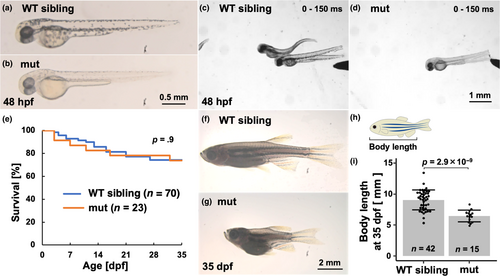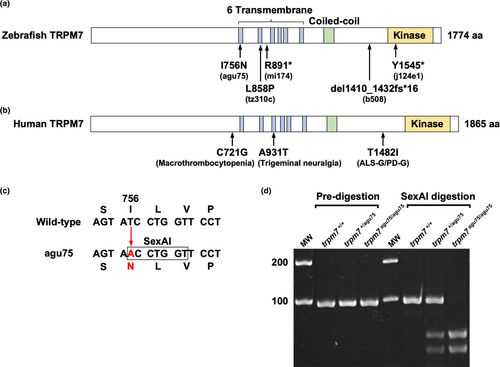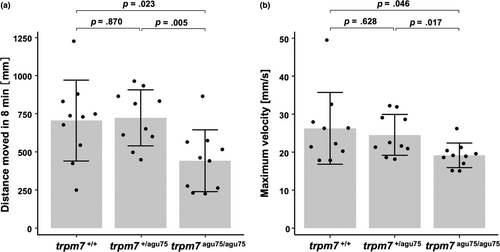- Title
-
Zebrafish trpm7 mutants show reduced motility in free movement
- Authors
- Watai, K., Sadamitsu, K., Wada, S., Kashima, M., Hirata, H.
- Source
- Full text @ Dev. Growth Diff.
|
Phenotypes of trpm7 mutants at embryonic and larval stages. (a–d) Phenotypes of trpm7 mutant embryos at 48 h post-fertilization (hpf). Lateral views of a wild-type (WT) sibling (a) and a mutant embryo (b). Superimposition of video frames showing traces of touch-evoked swimming of a wild-type sibling (c). A mutant embryo did not respond to touch (d). (e) The survival test of wild-type siblings and mutants. This result was not statistically significant by logrank test (p = .9). (f–h) Phenotypes of trpm7 mutants at 35 days post-fertilization (dpf). Lateral views of a wild-type sibling (f) and a mutant (g). Body length is defined by the distance from the snout tip to the base of the tail (h). (i) Body length of wild-type siblings and mutants at 35 dpf. PHENOTYPE:
|
|
Zebrafish and human trpm7 mutations. Graphic illustrations of zebrafish (a) and human (b) TRPM7 proteins. Positions of the nonsense, missense and frameshift mutations in zebrafish as well as pathologically relevant variants in human are indicated. (c) A thymine-to-adenine mutation generated a SexAI restriction site in zebrafish trpm7 gene. (d) Genotyping of trpm7 mutants. Note that PCR products (101 bp) amplified from the mutant allele were digested by SexAI to generate two fragments (59 bp and 42 bp). |
|
Behavioral analysis of trpm7 mutants at 5 days post-fertilization (dpf). (a) Total distance moved during 8 min of free swimming. (b) Maximum velocity during 8 min of free swimming. Note that trpm7agu75/agu75 mutants show reduced motility. n = 10 trials for each. PHENOTYPE:
|

ZFIN is incorporating published figure images and captions as part of an ongoing project. Figures from some publications have not yet been curated, or are not available for display because of copyright restrictions. |

Unillustrated author statements |



